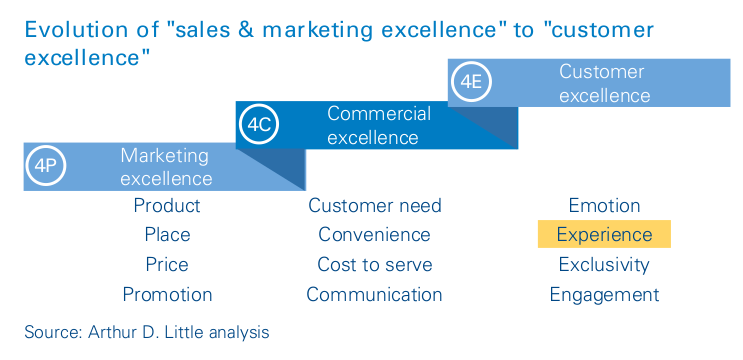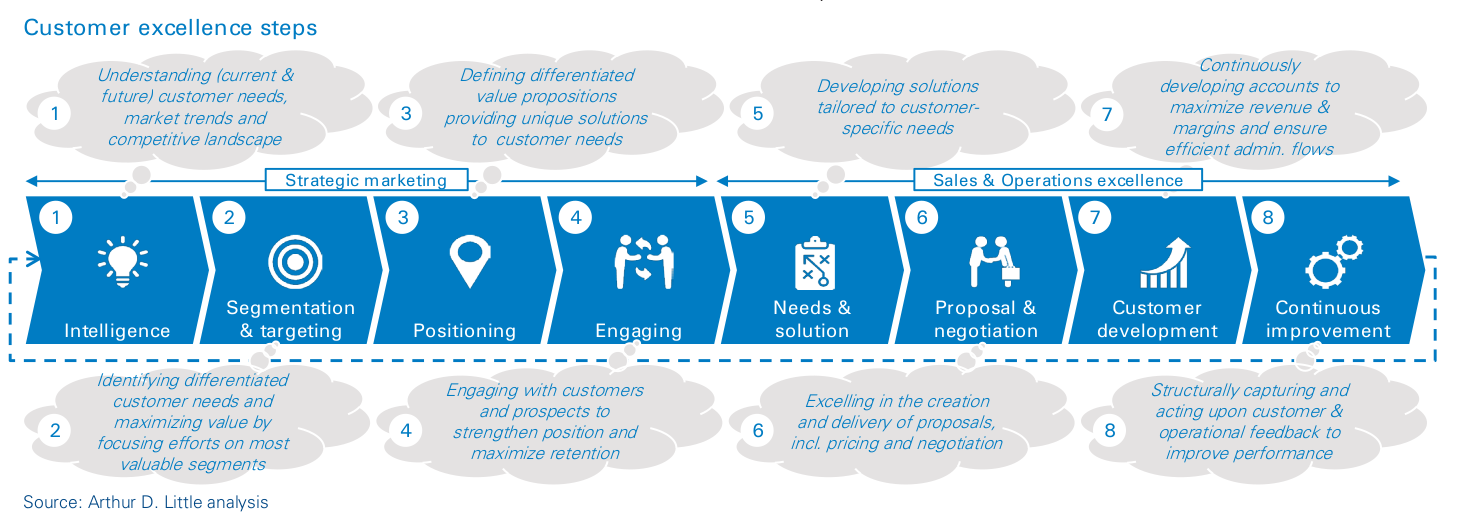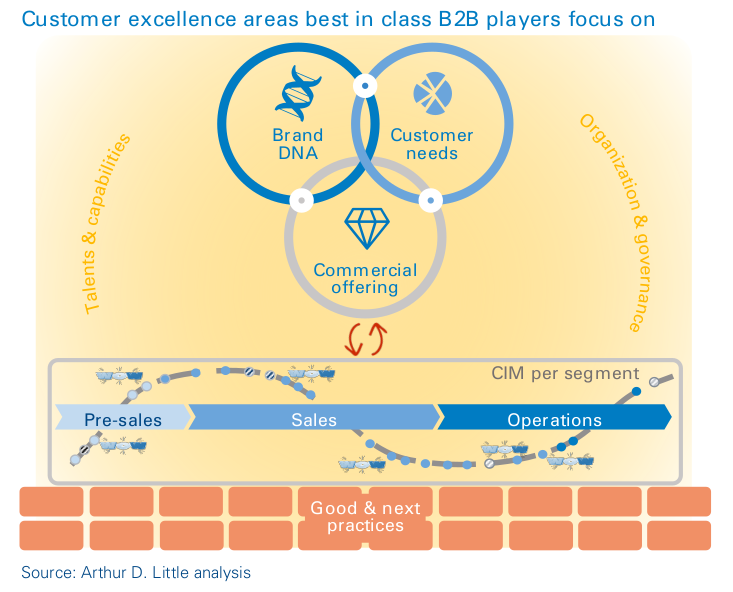
Saying that the world is undergoing a fast-paced transformation is not only stating the obvious, but also an understatement. Traditional business models and go-to-market strategies are challenged, and often even rendered obsolete, by rapidly evolving customer needs. In many cases, industry convergence has led to new entrants that have caused major disruptions to many established ecosystems using novel, more agile, business and operating models. This is just the tip of the iceberg. To remain successful and disrupt instead of being disrupted, best-in-class B2B organizations have understood the increasing importance of “experience” to maximize customer value. They have initiated profound transformations to develop customer preference and maximize margins.
Pressure from customers and the market is forcing companies to reinvent their commercial approaches
Evolving customer needs and technology are disrupting traditional ecosystems
Technological innovation and digitalization have caused a sharp increase in the rate at which customer needs are evolving. Customers increasingly require integrated digital solutions that are tailored to their current needs and flexible enough to accommodate potential future needs. Although at first it might look like B2C players would be the only ones affected, our experience shows that the impact on the B2B market is becoming more visible.
Business models and go-to-market strategies are increasingly being challenged
B2B customers are increasingly requiring more than simple products or services. The emergence of anything-as-a-service (XaaS) is just one trend that emphasizes evolution from stand- alone products and services towards integrated solutions. This and other changes in business models also open the market to potential new entrants.
The B2B sector is also lagging when it comes to exploiting the benefits of the sharing economy. However, start-ups are emerging that leverage the sharing economy towards B2B companies, such as Yard Club (which offers a way for construction companies to share their equipment by renting it out when they are not using it) and WeWork (which provides working space as a service).
Companies need to adapt their commercial approaches to develop customer preference and maximize margins
Because of the profound changes in the B2B ecosystem, companies are typically left with several fundamental commercial challenges:
- What are (unmet) needs in the market, and how do those differ across customer types?
- What is our unique selling proposition (USP), and to what extent does it differentiate us from competition?
- Does our product or service offering reflect those needs and our USP?
- Who are our most valuable customers/prospects?
- Are we focusing efforts (sales and ops) on them to maximize company value and customer satisfaction/ retention?
- How is this reflected in the operational service level (cost to serve)?
- How do we keep operating margin under control along the customer/contract lifecycle?
- ...
In addition, best-in-class players realize that the notion of experience is becoming central. While this has been valid for many years in B2C, it is now just as important in B2B. The evolution that “sales and marketing excellence” has been undergoing is schematically illustrated in the figure below. The traditional “four Ps” of “marketing excellence” (product, place, price and promotion), which have been around since the 1960s, have gradually developed through the “four Cs” of “commercial excellence” (customer needs, convenience, cost-to-serve and communication) to finally reach today’s “four Es” of “customer- centric commercial excellence”, or “customer excellence” (emotion, experience, exclusivity and engagement).
In the era of customer excellence, best-in-class B2B players realize that, to solve their commercial challenges and remain successful, they must put the customer at the center of everything they undertake. The end goal of customer excellence transformations is a situation in which customers:
- Can relate to the company’s unique value and brand attributes.
- Feel their needs are understood and the company strives for their satisfaction.
- Believe the company’s offering reflects these needs.
- Think the company is one step ahead of the market and differentiates itself by offering tailored solutions.
- Never cease to be positively surprised by the company.
- Are willing to pay a premium for the superior quality and experience of the company’s services.
Best-in-class B2B players have started a journey towards customer-centric commercial excellence
The customer excellence cycle continuously involves all functions along the customer journey
Several sales, marketing and operations processes are present in all established companies. However, in many companies, the degree of maturity of these processes often differs across business units, countries and divisions. In addition, sales, marketing and operations often work independently from each other. This leads to inconsistencies across organizational interfaces (e.g., for international customers expecting to receive the same value proposition across countries) and suboptimal performance. The lack of “common language” and collaboration across organizational boundaries (countries, departments, business units, etc.) leads to a missed opportunity for continuous improvement and a waste of efforts due to constant “reinvention of the wheel”.
To unleash the numerous benefits of customer excellence and achieve tangible improvements, an end-to-end approach addressing multiple dimensions across the customer journey is required. The eight key steps to customer excellence (see following figure), which cover practices across sales, marketing and operations, can be divided into two main parts. The first four steps, from intelligence up to engaging, are commonly referred to as “strategic marketing”. The last four steps, from needs & solution to continuous improvement, are, in turn, typically called “sales & operations excellence”. A big portion of B2B companies only focus on these last four steps, which then leads to misalignment between their value propositions and customer needs. Each of the eight steps is supported by several commercial excellence practices. The level of maturity required for each of these depends on company specifics and is informed by the company’s strategic vision, sense of purpose and brand. It is crucial for a company to find the right balance between “good practices” (for which maturity should be aligned with industry standards) and “next practices” (leading-edge activities that allow the company to differentiate from and outrun competitors).
To develop and maintain superior customer excellence, best-in-class B2B players focus on five main areas
- Providing customers with a branded experience.
- Understanding customer needs and tailoring commercial approaches accordingly.
- Reviewing product and service offerings to maximize added value.
- Continuously introducing selected “next practices”.
- Attracting/developing talents and capabilities, while transforming the organization and governance.
1. Providing customers with a branded experience
Defining a sense of purpose (“What is our company bringing to the world?”) is becoming a necessity for companies as they face business environment challenges. Defining or redefining the sense of purpose involves clearly determining the company’s identity, as well as the original and differentiating understanding of its role. However, “what the company brings to the world” and “what would be missing if the company disappeared” should be made explicit.
Defining a company’s sense of purpose (the “WHY” strategy) secures differentiation, allows for common storytelling to stakeholders, and drives transformation. The sense of purpose is at the heart of a business, as it drives its uniqueness and competitiveness. In addition, as a new generation enters the labor market, employers need to rethink their management approaches. Giving meaning is a necessity if a company is looking to hire millennials. The “WHY” strategy creates an “empowered” organization with a clear orientation, strong cultural cement, and an effective filter through which all company actions must pass. In the process, it facilitates a common language for clients, hiring of empowering people within a clear framework, and creation of a strong culture.
2. Understanding customer needs and tailoring commercial approaches accordingly
Voice-of-customer (VoC) analysis performed via in-depth, one- to-one interviews with customers and prospects, is gaining traction among leading B2B players. VoC is a critical lever to gain customer insight. As such, it is often the cornerstone of customer excellence transformation programs. It allows the company to learn about (unmet) needs and the current level of satisfaction relating to these needs. It also helps them understand perceived strengths and weaknesses, as well as differentiators versus competition.
Best-in-class players have a comprehensive approach that allows them to spot opportunities and focus commercial and operational efforts where value lies. Proactive prospect and customer engagement helps them achieve common focus and avoid duplication of efforts. In addition, it enables them to move from product/service delivery logic, in which the same effort is spent on all, to a situation in which efforts are allocated in line with customer value. In B2B, need-based market segmentation and targeting is a next practice that allows better understanding of differentiated market needs. The company can subsequently derive relevant need- and value-based segments from this. It can then focus its efforts and adapt its positioning strategy based on the attractiveness of a segment in the market, as well as its competitive positioning.
To activate the differentiated brand experience and positioning strategy identified through need-based segmentation and targeting exercises, best-in-class B2B players define individual customer interaction models (CIMs) tailored to each specific segment. These differentiated CIMs allow companies to identify the so-called moments of truth (touchpoints with positive experience) and pain points (touchpoints with negative experience) along the customer journey. From this, they can define how to activate their brand platforms on these different touchpoints through concrete actions (“emblematic proof”).
3. Reviewing product and service offerings to maximize added Value
The fast pace of technological innovation and customer evolution shortens the relevance of product and service offerings but creates opportunities to please customers in new ways. As a result, best-in-class players adopt continuous improvement logic when reviewing their product and service offerings. They ensure threshold needs remain satisfied, while well-chosen delighters or “WOW factors” allow for differentiation.
4. Continuously introducing selected “next practices”
Best-in-class players review the maturity and performance of their commercial practices regularly. Through best-practice sharing and continuous improvement mechanisms, they ensure that their commercial practices stay on par with industry standards. In addition, they selectively develop and introduce next practices that allow them to differentiate from and out- reach competition.
5. Attracting/developing talents and capabilities, while transforming the organization and governance
Organizational and cultural changes are often required to move a culture towards increased customer centricity. B2B players typically need to introduce or reinforce their strategic marketing capabilities and create dedicated functions. In addition, moving towards customer excellence often involves reviewing and adapting governance bodies and incentive schemes. Trends such as the increasing need for integrated solutions are affecting organizational structure and capabilities. Companies typically need to decide whether to develop in-house technology departments to increase control over their R&D functions.
Customer excellence should be seen as a continuous process and transformation enabler
Embarking on a customer excellence journey should be considered an opportunity to launch a transformation to anchor client centricity deeply within the organizational culture. The main benefits of a customer excellence transformation are threefold. First, the creation of a strong client-centric culture allows the company to improve staff engagement and preference. Second, it translates into customer loyalty and stickiness, increasing customer preference and retention while maximizing operating margins in the short- and long-term. Third, continuous differentiation versus competitors is emphasized thanks to the introduction of customer and operational feedback loops.
It is commonly known that the implementation phase is where most transformation programs fail. To maximize the chances of successful program implementation and organizational transformation, customer excellence programs should rely on collaborative approaches that aim to maximize buy-in from the main stakeholders early on and throughout the program.






